Investment Analysis Report: Comparing UK Investment Funds
VerifiedAdded on 2023/01/06
|13
|2904
|82
Report
AI Summary
This report provides a detailed analysis of the UK investment fund landscape, focusing on two prominent fund managers: BlackRock and Douglas Brodie. It begins with an overview of the UK asset management sector, highlighting its size and key trends. The report then delves into the specifics of each fund, examining their investment philosophies, portfolio management strategies, and asset allocation techniques. A comparison of BlackRock and Douglas Brodie is provided, including their investment performance over a five-year period, asset allocation, and fees. The analysis includes an examination of return on investment, mean, standard deviation, and correlation between both funds. The report concludes with recommendations based on the findings, offering insights into cost considerations and investment strategies. Overall, the report provides a comprehensive overview of the UK investment fund market and offers valuable insights for investors.
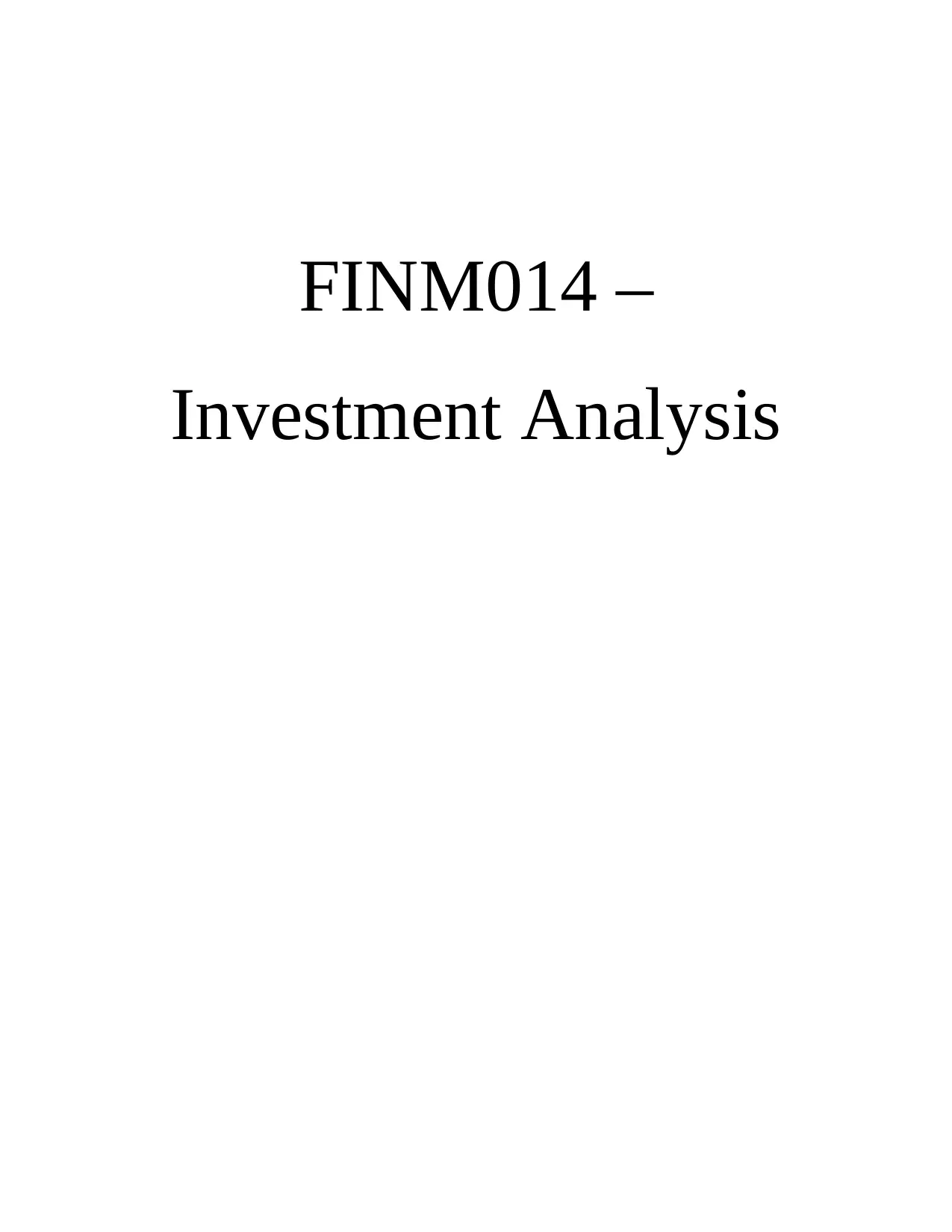
FINM014 –
Investment Analysis
Investment Analysis
Paraphrase This Document
Need a fresh take? Get an instant paraphrase of this document with our AI Paraphraser
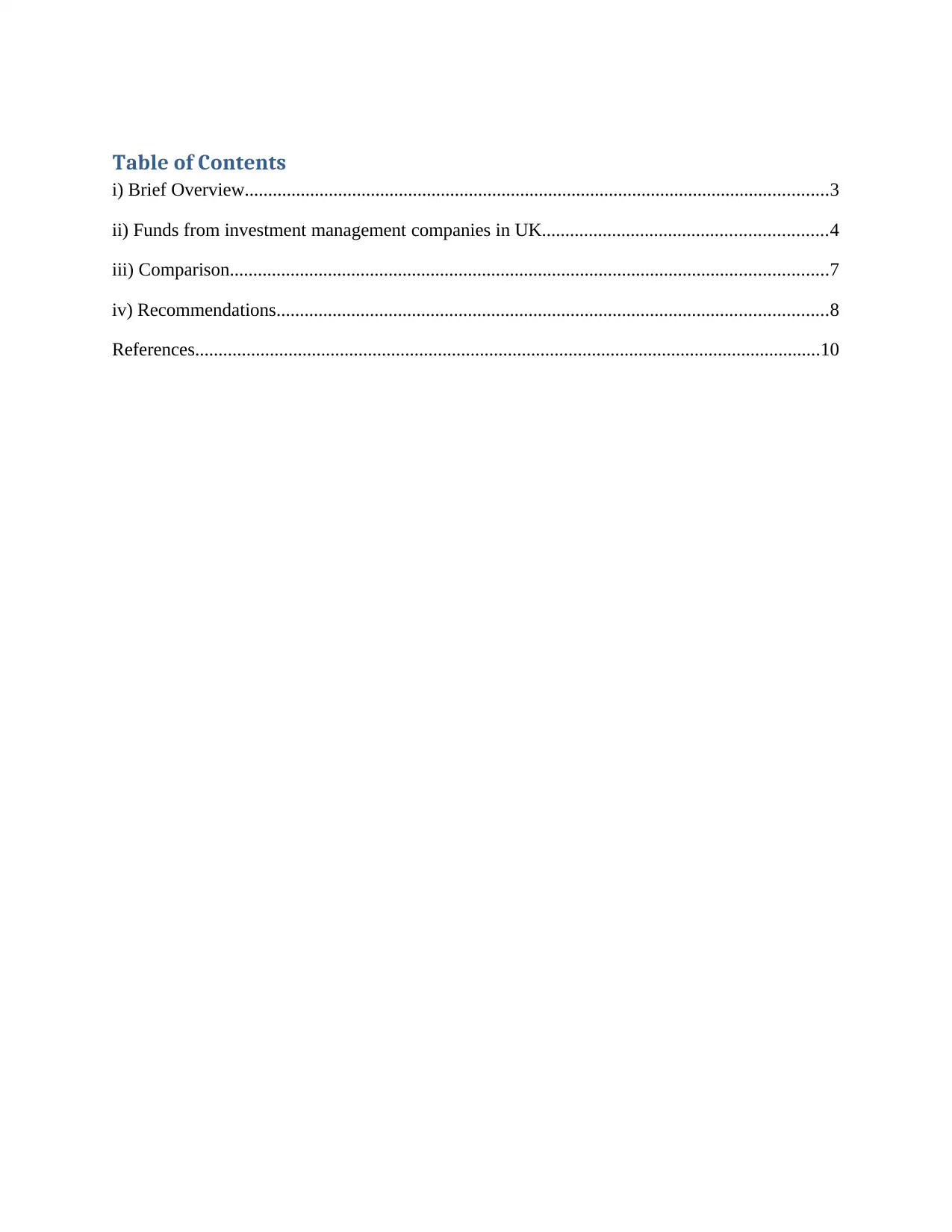
Table of Contents
i) Brief Overview.............................................................................................................................3
ii) Funds from investment management companies in UK.............................................................4
iii) Comparison................................................................................................................................7
iv) Recommendations......................................................................................................................8
References......................................................................................................................................10
i) Brief Overview.............................................................................................................................3
ii) Funds from investment management companies in UK.............................................................4
iii) Comparison................................................................................................................................7
iv) Recommendations......................................................................................................................8
References......................................................................................................................................10
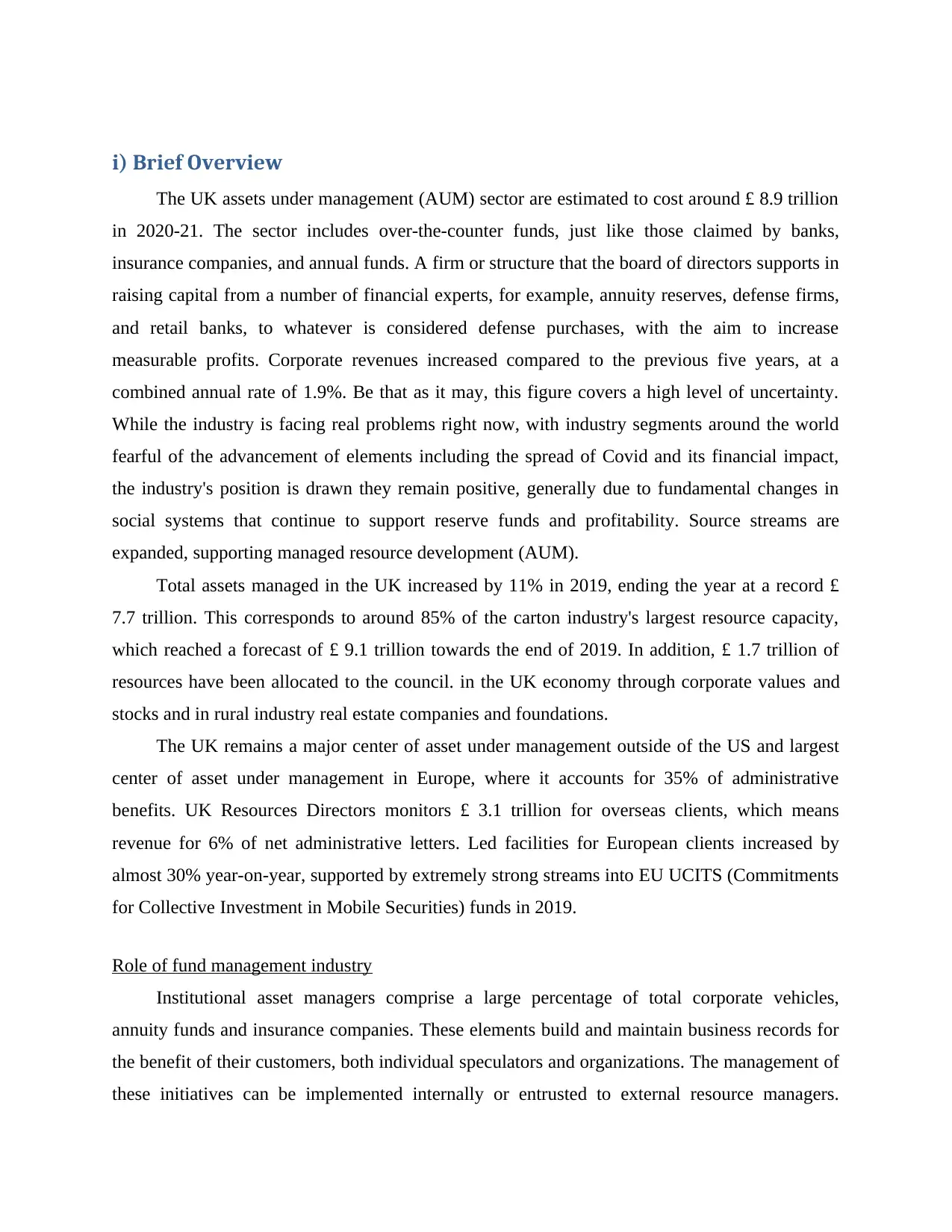
i) Brief Overview
The UK assets under management (AUM) sector are estimated to cost around £ 8.9 trillion
in 2020-21. The sector includes over-the-counter funds, just like those claimed by banks,
insurance companies, and annual funds. A firm or structure that the board of directors supports in
raising capital from a number of financial experts, for example, annuity reserves, defense firms,
and retail banks, to whatever is considered defense purchases, with the aim to increase
measurable profits. Corporate revenues increased compared to the previous five years, at a
combined annual rate of 1.9%. Be that as it may, this figure covers a high level of uncertainty.
While the industry is facing real problems right now, with industry segments around the world
fearful of the advancement of elements including the spread of Covid and its financial impact,
the industry's position is drawn they remain positive, generally due to fundamental changes in
social systems that continue to support reserve funds and profitability. Source streams are
expanded, supporting managed resource development (AUM).
Total assets managed in the UK increased by 11% in 2019, ending the year at a record £
7.7 trillion. This corresponds to around 85% of the carton industry's largest resource capacity,
which reached a forecast of £ 9.1 trillion towards the end of 2019. In addition, £ 1.7 trillion of
resources have been allocated to the council. in the UK economy through corporate values and
stocks and in rural industry real estate companies and foundations.
The UK remains a major center of asset under management outside of the US and largest
center of asset under management in Europe, where it accounts for 35% of administrative
benefits. UK Resources Directors monitors £ 3.1 trillion for overseas clients, which means
revenue for 6% of net administrative letters. Led facilities for European clients increased by
almost 30% year-on-year, supported by extremely strong streams into EU UCITS (Commitments
for Collective Investment in Mobile Securities) funds in 2019.
Role of fund management industry
Institutional asset managers comprise a large percentage of total corporate vehicles,
annuity funds and insurance companies. These elements build and maintain business records for
the benefit of their customers, both individual speculators and organizations. The management of
these initiatives can be implemented internally or entrusted to external resource managers.
The UK assets under management (AUM) sector are estimated to cost around £ 8.9 trillion
in 2020-21. The sector includes over-the-counter funds, just like those claimed by banks,
insurance companies, and annual funds. A firm or structure that the board of directors supports in
raising capital from a number of financial experts, for example, annuity reserves, defense firms,
and retail banks, to whatever is considered defense purchases, with the aim to increase
measurable profits. Corporate revenues increased compared to the previous five years, at a
combined annual rate of 1.9%. Be that as it may, this figure covers a high level of uncertainty.
While the industry is facing real problems right now, with industry segments around the world
fearful of the advancement of elements including the spread of Covid and its financial impact,
the industry's position is drawn they remain positive, generally due to fundamental changes in
social systems that continue to support reserve funds and profitability. Source streams are
expanded, supporting managed resource development (AUM).
Total assets managed in the UK increased by 11% in 2019, ending the year at a record £
7.7 trillion. This corresponds to around 85% of the carton industry's largest resource capacity,
which reached a forecast of £ 9.1 trillion towards the end of 2019. In addition, £ 1.7 trillion of
resources have been allocated to the council. in the UK economy through corporate values and
stocks and in rural industry real estate companies and foundations.
The UK remains a major center of asset under management outside of the US and largest
center of asset under management in Europe, where it accounts for 35% of administrative
benefits. UK Resources Directors monitors £ 3.1 trillion for overseas clients, which means
revenue for 6% of net administrative letters. Led facilities for European clients increased by
almost 30% year-on-year, supported by extremely strong streams into EU UCITS (Commitments
for Collective Investment in Mobile Securities) funds in 2019.
Role of fund management industry
Institutional asset managers comprise a large percentage of total corporate vehicles,
annuity funds and insurance companies. These elements build and maintain business records for
the benefit of their customers, both individual speculators and organizations. The management of
these initiatives can be implemented internally or entrusted to external resource managers.
⊘ This is a preview!⊘
Do you want full access?
Subscribe today to unlock all pages.

Trusted by 1+ million students worldwide
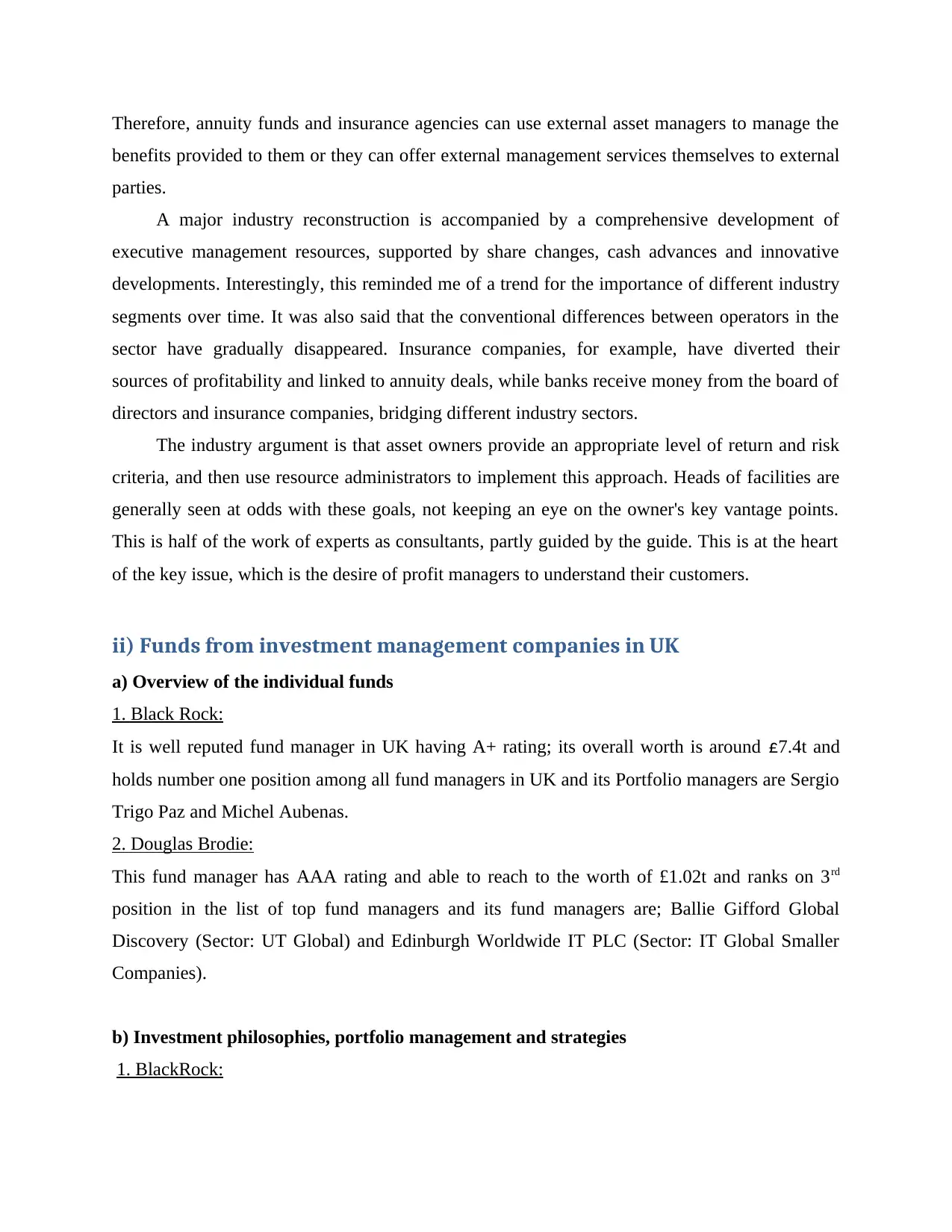
Therefore, annuity funds and insurance agencies can use external asset managers to manage the
benefits provided to them or they can offer external management services themselves to external
parties.
A major industry reconstruction is accompanied by a comprehensive development of
executive management resources, supported by share changes, cash advances and innovative
developments. Interestingly, this reminded me of a trend for the importance of different industry
segments over time. It was also said that the conventional differences between operators in the
sector have gradually disappeared. Insurance companies, for example, have diverted their
sources of profitability and linked to annuity deals, while banks receive money from the board of
directors and insurance companies, bridging different industry sectors.
The industry argument is that asset owners provide an appropriate level of return and risk
criteria, and then use resource administrators to implement this approach. Heads of facilities are
generally seen at odds with these goals, not keeping an eye on the owner's key vantage points.
This is half of the work of experts as consultants, partly guided by the guide. This is at the heart
of the key issue, which is the desire of profit managers to understand their customers.
ii) Funds from investment management companies in UK
a) Overview of the individual funds
1. Black Rock:
It is well reputed fund manager in UK having A+ rating; its overall worth is around £7.4t and
holds number one position among all fund managers in UK and its Portfolio managers are Sergio
Trigo Paz and Michel Aubenas.
2. Douglas Brodie:
This fund manager has AAA rating and able to reach to the worth of £1.02t and ranks on 3rd
position in the list of top fund managers and its fund managers are; Ballie Gifford Global
Discovery (Sector: UT Global) and Edinburgh Worldwide IT PLC (Sector: IT Global Smaller
Companies).
b) Investment philosophies, portfolio management and strategies
1. BlackRock:
benefits provided to them or they can offer external management services themselves to external
parties.
A major industry reconstruction is accompanied by a comprehensive development of
executive management resources, supported by share changes, cash advances and innovative
developments. Interestingly, this reminded me of a trend for the importance of different industry
segments over time. It was also said that the conventional differences between operators in the
sector have gradually disappeared. Insurance companies, for example, have diverted their
sources of profitability and linked to annuity deals, while banks receive money from the board of
directors and insurance companies, bridging different industry sectors.
The industry argument is that asset owners provide an appropriate level of return and risk
criteria, and then use resource administrators to implement this approach. Heads of facilities are
generally seen at odds with these goals, not keeping an eye on the owner's key vantage points.
This is half of the work of experts as consultants, partly guided by the guide. This is at the heart
of the key issue, which is the desire of profit managers to understand their customers.
ii) Funds from investment management companies in UK
a) Overview of the individual funds
1. Black Rock:
It is well reputed fund manager in UK having A+ rating; its overall worth is around £7.4t and
holds number one position among all fund managers in UK and its Portfolio managers are Sergio
Trigo Paz and Michel Aubenas.
2. Douglas Brodie:
This fund manager has AAA rating and able to reach to the worth of £1.02t and ranks on 3rd
position in the list of top fund managers and its fund managers are; Ballie Gifford Global
Discovery (Sector: UT Global) and Edinburgh Worldwide IT PLC (Sector: IT Global Smaller
Companies).
b) Investment philosophies, portfolio management and strategies
1. BlackRock:
Paraphrase This Document
Need a fresh take? Get an instant paraphrase of this document with our AI Paraphraser
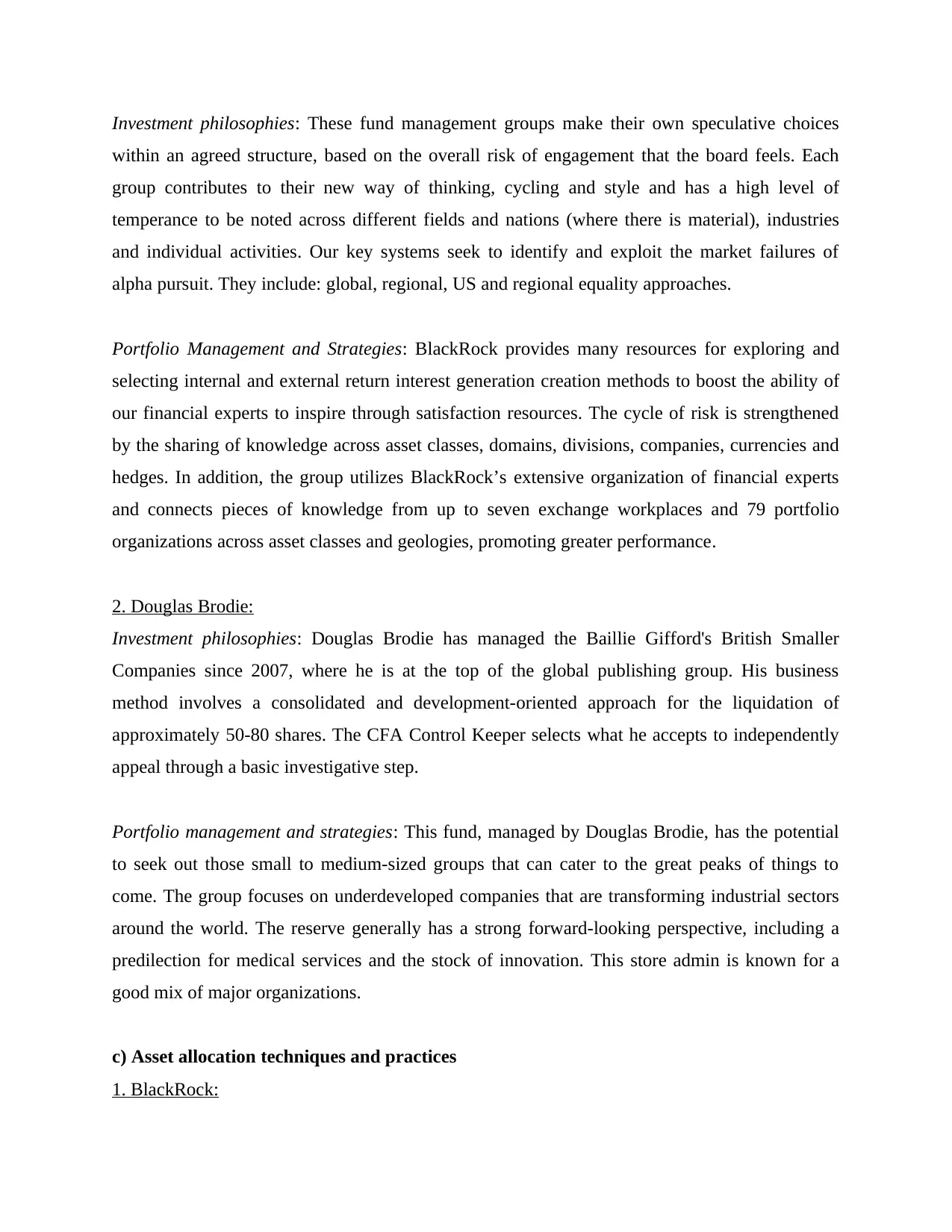
Investment philosophies: These fund management groups make their own speculative choices
within an agreed structure, based on the overall risk of engagement that the board feels. Each
group contributes to their new way of thinking, cycling and style and has a high level of
temperance to be noted across different fields and nations (where there is material), industries
and individual activities. Our key systems seek to identify and exploit the market failures of
alpha pursuit. They include: global, regional, US and regional equality approaches.
Portfolio Management and Strategies: BlackRock provides many resources for exploring and
selecting internal and external return interest generation creation methods to boost the ability of
our financial experts to inspire through satisfaction resources. The cycle of risk is strengthened
by the sharing of knowledge across asset classes, domains, divisions, companies, currencies and
hedges. In addition, the group utilizes BlackRock’s extensive organization of financial experts
and connects pieces of knowledge from up to seven exchange workplaces and 79 portfolio
organizations across asset classes and geologies, promoting greater performance.
2. Douglas Brodie:
Investment philosophies: Douglas Brodie has managed the Baillie Gifford's British Smaller
Companies since 2007, where he is at the top of the global publishing group. His business
method involves a consolidated and development-oriented approach for the liquidation of
approximately 50-80 shares. The CFA Control Keeper selects what he accepts to independently
appeal through a basic investigative step.
Portfolio management and strategies: This fund, managed by Douglas Brodie, has the potential
to seek out those small to medium-sized groups that can cater to the great peaks of things to
come. The group focuses on underdeveloped companies that are transforming industrial sectors
around the world. The reserve generally has a strong forward-looking perspective, including a
predilection for medical services and the stock of innovation. This store admin is known for a
good mix of major organizations.
c) Asset allocation techniques and practices
1. BlackRock:
within an agreed structure, based on the overall risk of engagement that the board feels. Each
group contributes to their new way of thinking, cycling and style and has a high level of
temperance to be noted across different fields and nations (where there is material), industries
and individual activities. Our key systems seek to identify and exploit the market failures of
alpha pursuit. They include: global, regional, US and regional equality approaches.
Portfolio Management and Strategies: BlackRock provides many resources for exploring and
selecting internal and external return interest generation creation methods to boost the ability of
our financial experts to inspire through satisfaction resources. The cycle of risk is strengthened
by the sharing of knowledge across asset classes, domains, divisions, companies, currencies and
hedges. In addition, the group utilizes BlackRock’s extensive organization of financial experts
and connects pieces of knowledge from up to seven exchange workplaces and 79 portfolio
organizations across asset classes and geologies, promoting greater performance.
2. Douglas Brodie:
Investment philosophies: Douglas Brodie has managed the Baillie Gifford's British Smaller
Companies since 2007, where he is at the top of the global publishing group. His business
method involves a consolidated and development-oriented approach for the liquidation of
approximately 50-80 shares. The CFA Control Keeper selects what he accepts to independently
appeal through a basic investigative step.
Portfolio management and strategies: This fund, managed by Douglas Brodie, has the potential
to seek out those small to medium-sized groups that can cater to the great peaks of things to
come. The group focuses on underdeveloped companies that are transforming industrial sectors
around the world. The reserve generally has a strong forward-looking perspective, including a
predilection for medical services and the stock of innovation. This store admin is known for a
good mix of major organizations.
c) Asset allocation techniques and practices
1. BlackRock:
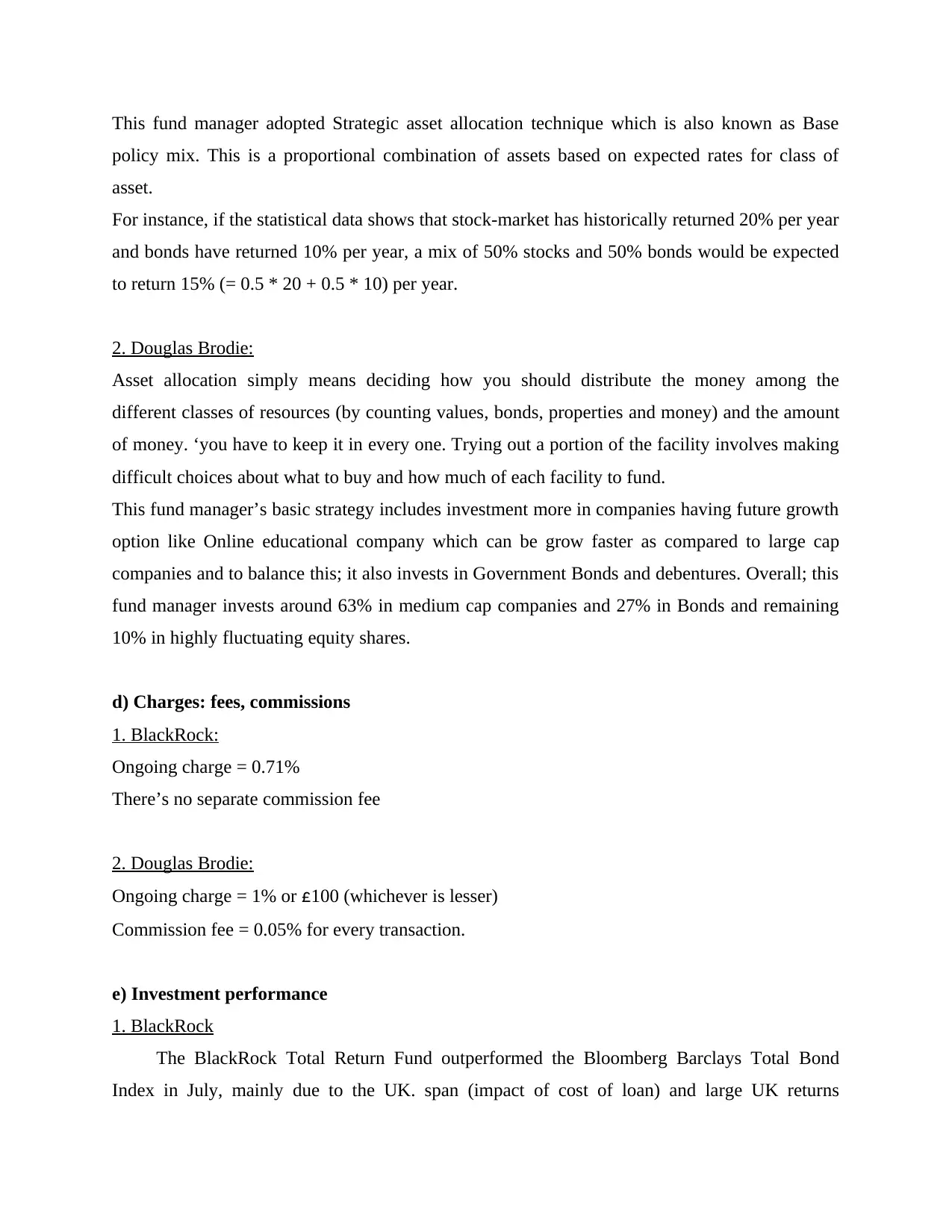
This fund manager adopted Strategic asset allocation technique which is also known as Base
policy mix. This is a proportional combination of assets based on expected rates for class of
asset.
For instance, if the statistical data shows that stock-market has historically returned 20% per year
and bonds have returned 10% per year, a mix of 50% stocks and 50% bonds would be expected
to return 15% (= 0.5 * 20 + 0.5 * 10) per year.
2. Douglas Brodie:
Asset allocation simply means deciding how you should distribute the money among the
different classes of resources (by counting values, bonds, properties and money) and the amount
of money. ‘you have to keep it in every one. Trying out a portion of the facility involves making
difficult choices about what to buy and how much of each facility to fund.
This fund manager’s basic strategy includes investment more in companies having future growth
option like Online educational company which can be grow faster as compared to large cap
companies and to balance this; it also invests in Government Bonds and debentures. Overall; this
fund manager invests around 63% in medium cap companies and 27% in Bonds and remaining
10% in highly fluctuating equity shares.
d) Charges: fees, commissions
1. BlackRock:
Ongoing charge = 0.71%
There’s no separate commission fee
2. Douglas Brodie:
Ongoing charge = 1% or £100 (whichever is lesser)
Commission fee = 0.05% for every transaction.
e) Investment performance
1. BlackRock
The BlackRock Total Return Fund outperformed the Bloomberg Barclays Total Bond
Index in July, mainly due to the UK. span (impact of cost of loan) and large UK returns
policy mix. This is a proportional combination of assets based on expected rates for class of
asset.
For instance, if the statistical data shows that stock-market has historically returned 20% per year
and bonds have returned 10% per year, a mix of 50% stocks and 50% bonds would be expected
to return 15% (= 0.5 * 20 + 0.5 * 10) per year.
2. Douglas Brodie:
Asset allocation simply means deciding how you should distribute the money among the
different classes of resources (by counting values, bonds, properties and money) and the amount
of money. ‘you have to keep it in every one. Trying out a portion of the facility involves making
difficult choices about what to buy and how much of each facility to fund.
This fund manager’s basic strategy includes investment more in companies having future growth
option like Online educational company which can be grow faster as compared to large cap
companies and to balance this; it also invests in Government Bonds and debentures. Overall; this
fund manager invests around 63% in medium cap companies and 27% in Bonds and remaining
10% in highly fluctuating equity shares.
d) Charges: fees, commissions
1. BlackRock:
Ongoing charge = 0.71%
There’s no separate commission fee
2. Douglas Brodie:
Ongoing charge = 1% or £100 (whichever is lesser)
Commission fee = 0.05% for every transaction.
e) Investment performance
1. BlackRock
The BlackRock Total Return Fund outperformed the Bloomberg Barclays Total Bond
Index in July, mainly due to the UK. span (impact of cost of loan) and large UK returns
⊘ This is a preview!⊘
Do you want full access?
Subscribe today to unlock all pages.

Trusted by 1+ million students worldwide
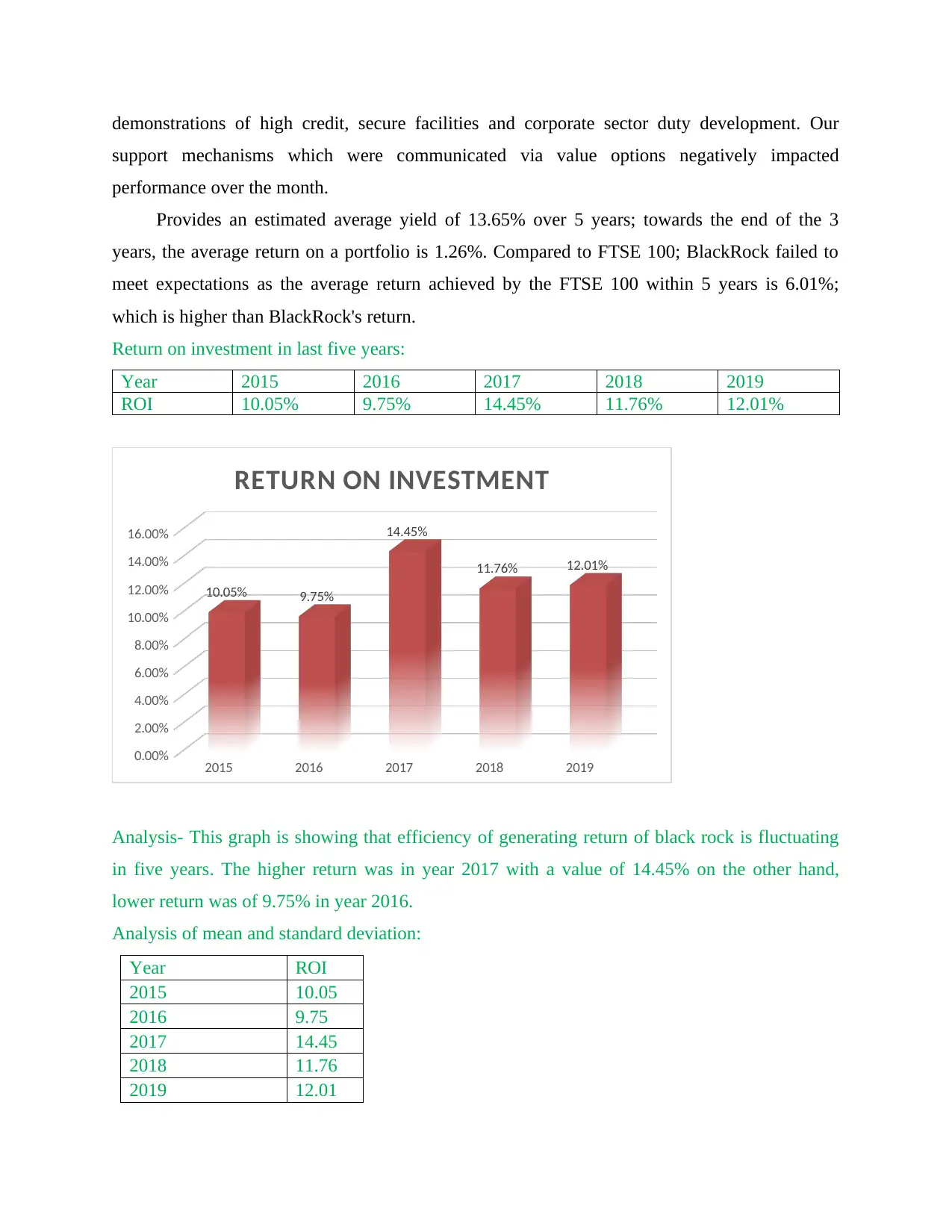
demonstrations of high credit, secure facilities and corporate sector duty development. Our
support mechanisms which were communicated via value options negatively impacted
performance over the month.
Provides an estimated average yield of 13.65% over 5 years; towards the end of the 3
years, the average return on a portfolio is 1.26%. Compared to FTSE 100; BlackRock failed to
meet expectations as the average return achieved by the FTSE 100 within 5 years is 6.01%;
which is higher than BlackRock's return.
Return on investment in last five years:
Year 2015 2016 2017 2018 2019
ROI 10.05% 9.75% 14.45% 11.76% 12.01%
2015 2016 2017 2018 2019
0.00%
2.00%
4.00%
6.00%
8.00%
10.00%
12.00%
14.00%
16.00%
10.05% 9.75%
14.45%
11.76% 12.01%
RETURN ON INVESTMENT
Analysis- This graph is showing that efficiency of generating return of black rock is fluctuating
in five years. The higher return was in year 2017 with a value of 14.45% on the other hand,
lower return was of 9.75% in year 2016.
Analysis of mean and standard deviation:
Year ROI
2015 10.05
2016 9.75
2017 14.45
2018 11.76
2019 12.01
support mechanisms which were communicated via value options negatively impacted
performance over the month.
Provides an estimated average yield of 13.65% over 5 years; towards the end of the 3
years, the average return on a portfolio is 1.26%. Compared to FTSE 100; BlackRock failed to
meet expectations as the average return achieved by the FTSE 100 within 5 years is 6.01%;
which is higher than BlackRock's return.
Return on investment in last five years:
Year 2015 2016 2017 2018 2019
ROI 10.05% 9.75% 14.45% 11.76% 12.01%
2015 2016 2017 2018 2019
0.00%
2.00%
4.00%
6.00%
8.00%
10.00%
12.00%
14.00%
16.00%
10.05% 9.75%
14.45%
11.76% 12.01%
RETURN ON INVESTMENT
Analysis- This graph is showing that efficiency of generating return of black rock is fluctuating
in five years. The higher return was in year 2017 with a value of 14.45% on the other hand,
lower return was of 9.75% in year 2016.
Analysis of mean and standard deviation:
Year ROI
2015 10.05
2016 9.75
2017 14.45
2018 11.76
2019 12.01
Paraphrase This Document
Need a fresh take? Get an instant paraphrase of this document with our AI Paraphraser
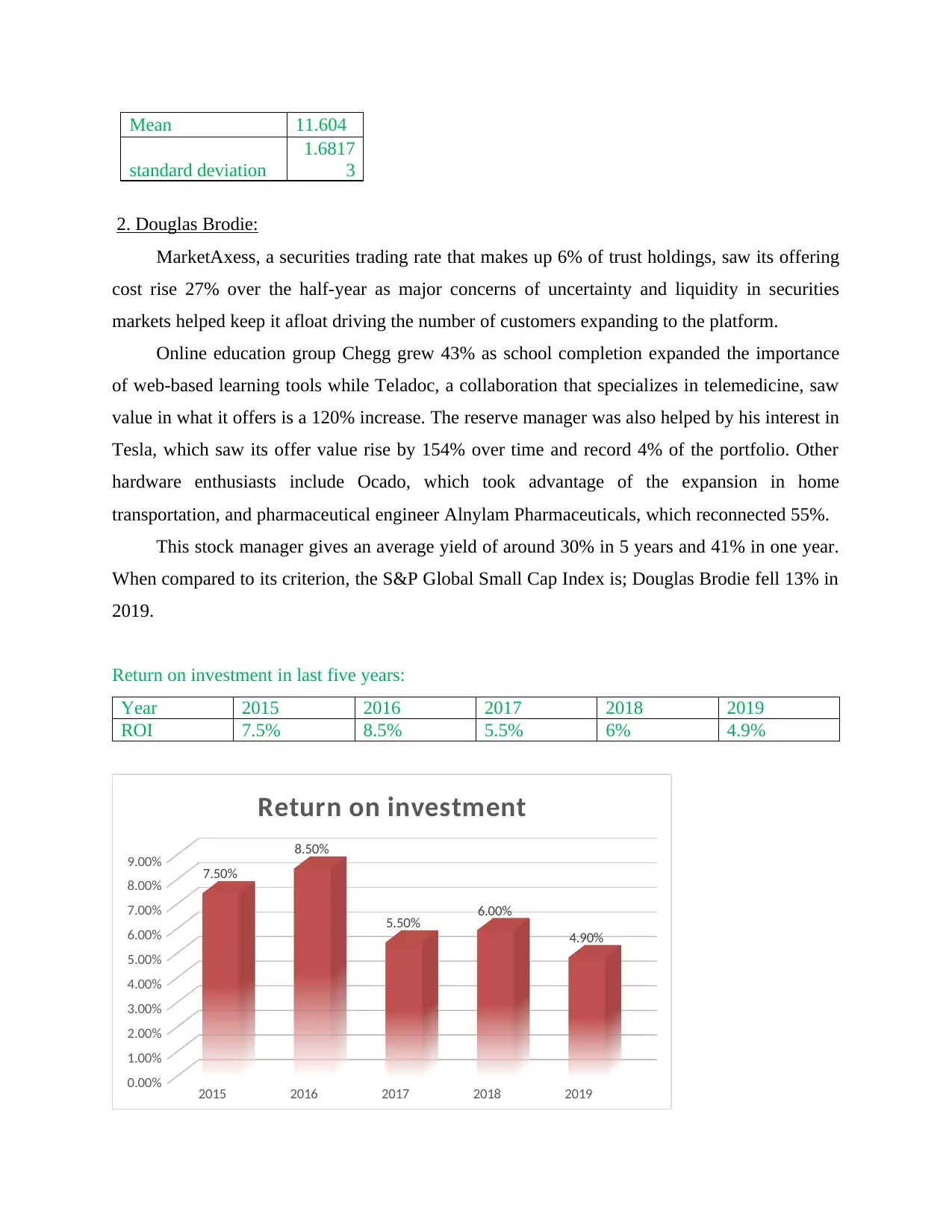
Mean 11.604
standard deviation
1.6817
3
2. Douglas Brodie:
MarketAxess, a securities trading rate that makes up 6% of trust holdings, saw its offering
cost rise 27% over the half-year as major concerns of uncertainty and liquidity in securities
markets helped keep it afloat driving the number of customers expanding to the platform.
Online education group Chegg grew 43% as school completion expanded the importance
of web-based learning tools while Teladoc, a collaboration that specializes in telemedicine, saw
value in what it offers is a 120% increase. The reserve manager was also helped by his interest in
Tesla, which saw its offer value rise by 154% over time and record 4% of the portfolio. Other
hardware enthusiasts include Ocado, which took advantage of the expansion in home
transportation, and pharmaceutical engineer Alnylam Pharmaceuticals, which reconnected 55%.
This stock manager gives an average yield of around 30% in 5 years and 41% in one year.
When compared to its criterion, the S&P Global Small Cap Index is; Douglas Brodie fell 13% in
2019.
Return on investment in last five years:
Year 2015 2016 2017 2018 2019
ROI 7.5% 8.5% 5.5% 6% 4.9%
2015 2016 2017 2018 2019
0.00%
1.00%
2.00%
3.00%
4.00%
5.00%
6.00%
7.00%
8.00%
9.00% 7.50%
8.50%
5.50% 6.00%
4.90%
Return on investment
standard deviation
1.6817
3
2. Douglas Brodie:
MarketAxess, a securities trading rate that makes up 6% of trust holdings, saw its offering
cost rise 27% over the half-year as major concerns of uncertainty and liquidity in securities
markets helped keep it afloat driving the number of customers expanding to the platform.
Online education group Chegg grew 43% as school completion expanded the importance
of web-based learning tools while Teladoc, a collaboration that specializes in telemedicine, saw
value in what it offers is a 120% increase. The reserve manager was also helped by his interest in
Tesla, which saw its offer value rise by 154% over time and record 4% of the portfolio. Other
hardware enthusiasts include Ocado, which took advantage of the expansion in home
transportation, and pharmaceutical engineer Alnylam Pharmaceuticals, which reconnected 55%.
This stock manager gives an average yield of around 30% in 5 years and 41% in one year.
When compared to its criterion, the S&P Global Small Cap Index is; Douglas Brodie fell 13% in
2019.
Return on investment in last five years:
Year 2015 2016 2017 2018 2019
ROI 7.5% 8.5% 5.5% 6% 4.9%
2015 2016 2017 2018 2019
0.00%
1.00%
2.00%
3.00%
4.00%
5.00%
6.00%
7.00%
8.00%
9.00% 7.50%
8.50%
5.50% 6.00%
4.90%
Return on investment
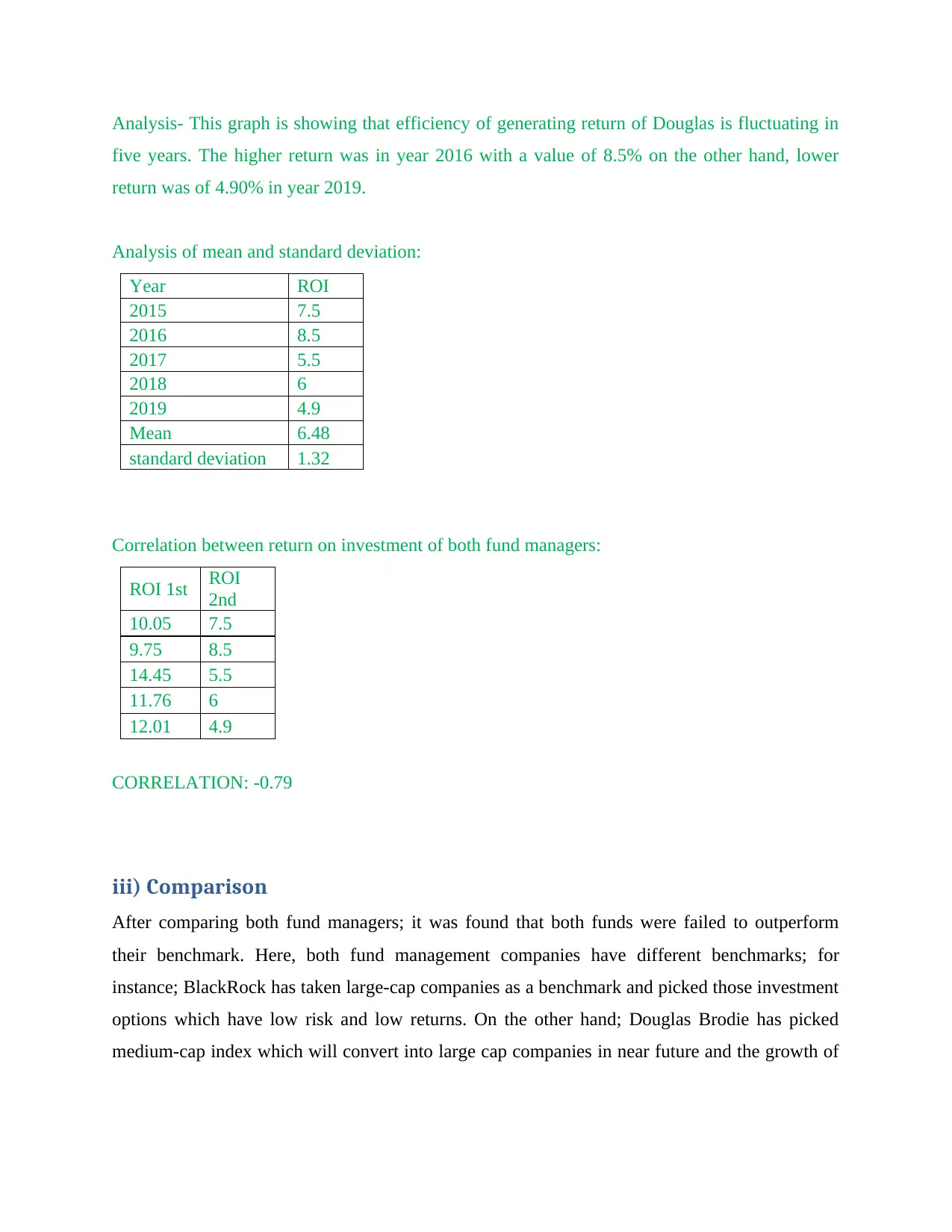
Analysis- This graph is showing that efficiency of generating return of Douglas is fluctuating in
five years. The higher return was in year 2016 with a value of 8.5% on the other hand, lower
return was of 4.90% in year 2019.
Analysis of mean and standard deviation:
Year ROI
2015 7.5
2016 8.5
2017 5.5
2018 6
2019 4.9
Mean 6.48
standard deviation 1.32
Correlation between return on investment of both fund managers:
ROI 1st ROI
2nd
10.05 7.5
9.75 8.5
14.45 5.5
11.76 6
12.01 4.9
CORRELATION: -0.79
iii) Comparison
After comparing both fund managers; it was found that both funds were failed to outperform
their benchmark. Here, both fund management companies have different benchmarks; for
instance; BlackRock has taken large-cap companies as a benchmark and picked those investment
options which have low risk and low returns. On the other hand; Douglas Brodie has picked
medium-cap index which will convert into large cap companies in near future and the growth of
five years. The higher return was in year 2016 with a value of 8.5% on the other hand, lower
return was of 4.90% in year 2019.
Analysis of mean and standard deviation:
Year ROI
2015 7.5
2016 8.5
2017 5.5
2018 6
2019 4.9
Mean 6.48
standard deviation 1.32
Correlation between return on investment of both fund managers:
ROI 1st ROI
2nd
10.05 7.5
9.75 8.5
14.45 5.5
11.76 6
12.01 4.9
CORRELATION: -0.79
iii) Comparison
After comparing both fund managers; it was found that both funds were failed to outperform
their benchmark. Here, both fund management companies have different benchmarks; for
instance; BlackRock has taken large-cap companies as a benchmark and picked those investment
options which have low risk and low returns. On the other hand; Douglas Brodie has picked
medium-cap index which will convert into large cap companies in near future and the growth of
⊘ This is a preview!⊘
Do you want full access?
Subscribe today to unlock all pages.

Trusted by 1+ million students worldwide
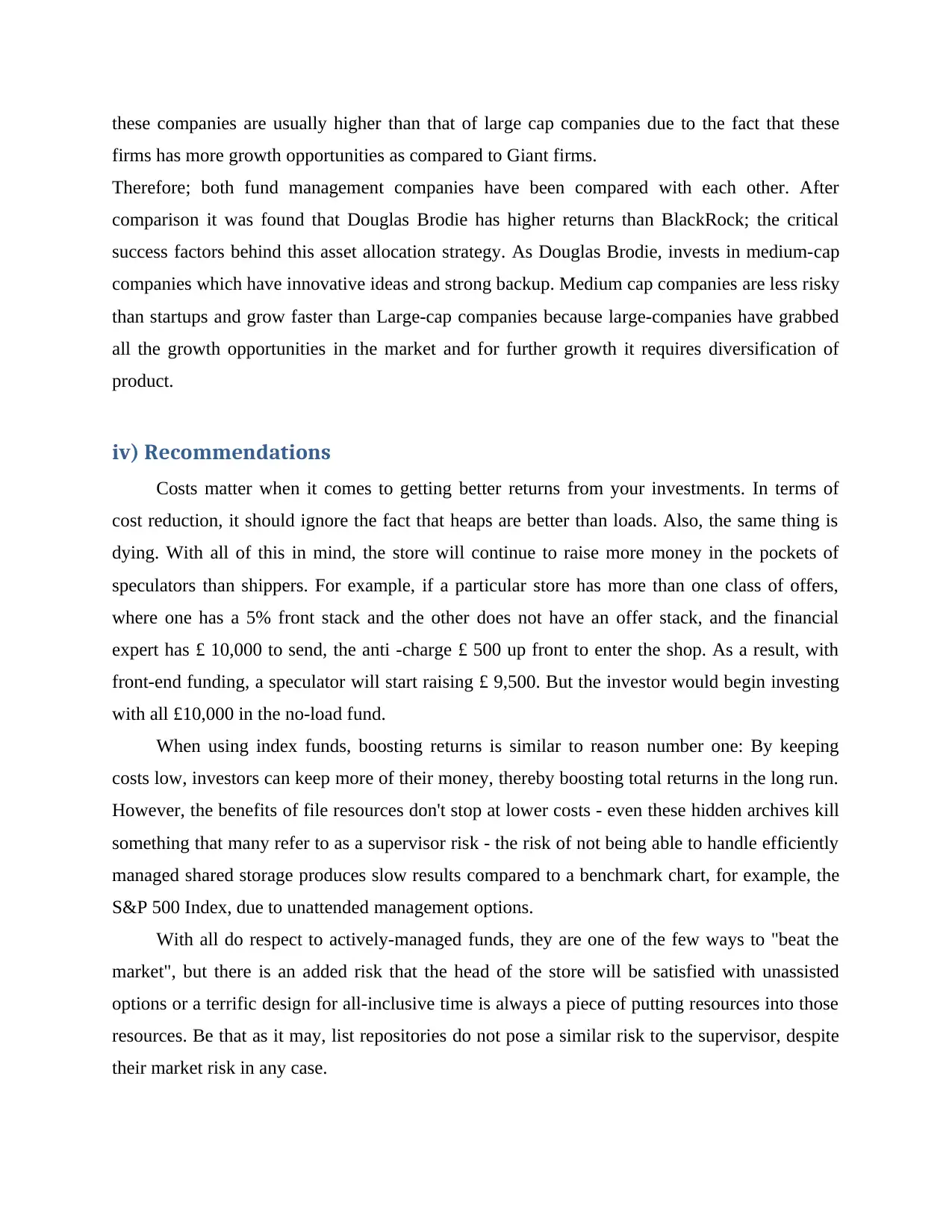
these companies are usually higher than that of large cap companies due to the fact that these
firms has more growth opportunities as compared to Giant firms.
Therefore; both fund management companies have been compared with each other. After
comparison it was found that Douglas Brodie has higher returns than BlackRock; the critical
success factors behind this asset allocation strategy. As Douglas Brodie, invests in medium-cap
companies which have innovative ideas and strong backup. Medium cap companies are less risky
than startups and grow faster than Large-cap companies because large-companies have grabbed
all the growth opportunities in the market and for further growth it requires diversification of
product.
iv) Recommendations
Costs matter when it comes to getting better returns from your investments. In terms of
cost reduction, it should ignore the fact that heaps are better than loads. Also, the same thing is
dying. With all of this in mind, the store will continue to raise more money in the pockets of
speculators than shippers. For example, if a particular store has more than one class of offers,
where one has a 5% front stack and the other does not have an offer stack, and the financial
expert has £ 10,000 to send, the anti -charge £ 500 up front to enter the shop. As a result, with
front-end funding, a speculator will start raising £ 9,500. But the investor would begin investing
with all £10,000 in the no-load fund.
When using index funds, boosting returns is similar to reason number one: By keeping
costs low, investors can keep more of their money, thereby boosting total returns in the long run.
However, the benefits of file resources don't stop at lower costs - even these hidden archives kill
something that many refer to as a supervisor risk - the risk of not being able to handle efficiently
managed shared storage produces slow results compared to a benchmark chart, for example, the
S&P 500 Index, due to unattended management options.
With all do respect to actively-managed funds, they are one of the few ways to "beat the
market", but there is an added risk that the head of the store will be satisfied with unassisted
options or a terrific design for all-inclusive time is always a piece of putting resources into those
resources. Be that as it may, list repositories do not pose a similar risk to the supervisor, despite
their market risk in any case.
firms has more growth opportunities as compared to Giant firms.
Therefore; both fund management companies have been compared with each other. After
comparison it was found that Douglas Brodie has higher returns than BlackRock; the critical
success factors behind this asset allocation strategy. As Douglas Brodie, invests in medium-cap
companies which have innovative ideas and strong backup. Medium cap companies are less risky
than startups and grow faster than Large-cap companies because large-companies have grabbed
all the growth opportunities in the market and for further growth it requires diversification of
product.
iv) Recommendations
Costs matter when it comes to getting better returns from your investments. In terms of
cost reduction, it should ignore the fact that heaps are better than loads. Also, the same thing is
dying. With all of this in mind, the store will continue to raise more money in the pockets of
speculators than shippers. For example, if a particular store has more than one class of offers,
where one has a 5% front stack and the other does not have an offer stack, and the financial
expert has £ 10,000 to send, the anti -charge £ 500 up front to enter the shop. As a result, with
front-end funding, a speculator will start raising £ 9,500. But the investor would begin investing
with all £10,000 in the no-load fund.
When using index funds, boosting returns is similar to reason number one: By keeping
costs low, investors can keep more of their money, thereby boosting total returns in the long run.
However, the benefits of file resources don't stop at lower costs - even these hidden archives kill
something that many refer to as a supervisor risk - the risk of not being able to handle efficiently
managed shared storage produces slow results compared to a benchmark chart, for example, the
S&P 500 Index, due to unattended management options.
With all do respect to actively-managed funds, they are one of the few ways to "beat the
market", but there is an added risk that the head of the store will be satisfied with unassisted
options or a terrific design for all-inclusive time is always a piece of putting resources into those
resources. Be that as it may, list repositories do not pose a similar risk to the supervisor, despite
their market risk in any case.
Paraphrase This Document
Need a fresh take? Get an instant paraphrase of this document with our AI Paraphraser
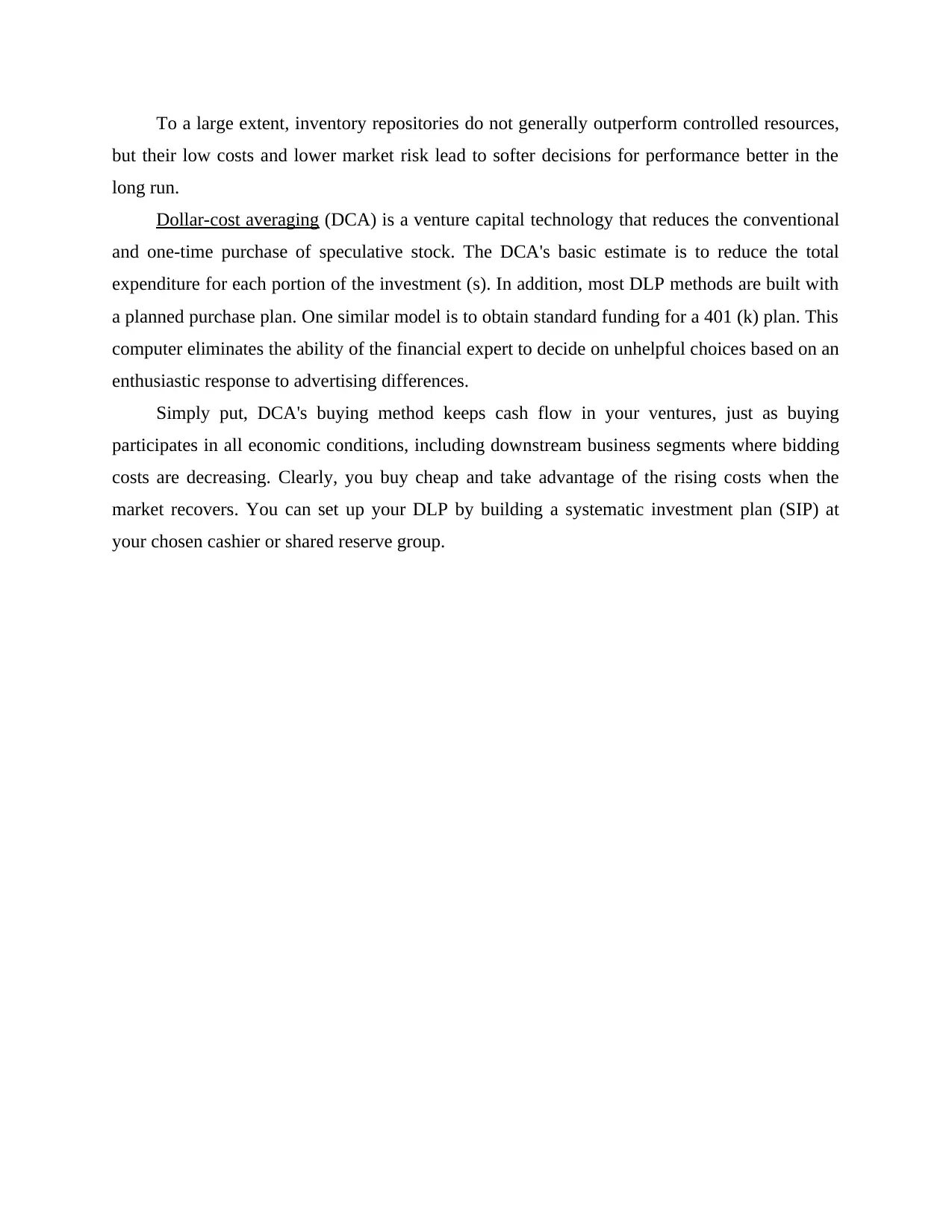
To a large extent, inventory repositories do not generally outperform controlled resources,
but their low costs and lower market risk lead to softer decisions for performance better in the
long run.
Dollar-cost averaging (DCA) is a venture capital technology that reduces the conventional
and one-time purchase of speculative stock. The DCA's basic estimate is to reduce the total
expenditure for each portion of the investment (s). In addition, most DLP methods are built with
a planned purchase plan. One similar model is to obtain standard funding for a 401 (k) plan. This
computer eliminates the ability of the financial expert to decide on unhelpful choices based on an
enthusiastic response to advertising differences.
Simply put, DCA's buying method keeps cash flow in your ventures, just as buying
participates in all economic conditions, including downstream business segments where bidding
costs are decreasing. Clearly, you buy cheap and take advantage of the rising costs when the
market recovers. You can set up your DLP by building a systematic investment plan (SIP) at
your chosen cashier or shared reserve group.
but their low costs and lower market risk lead to softer decisions for performance better in the
long run.
Dollar-cost averaging (DCA) is a venture capital technology that reduces the conventional
and one-time purchase of speculative stock. The DCA's basic estimate is to reduce the total
expenditure for each portion of the investment (s). In addition, most DLP methods are built with
a planned purchase plan. One similar model is to obtain standard funding for a 401 (k) plan. This
computer eliminates the ability of the financial expert to decide on unhelpful choices based on an
enthusiastic response to advertising differences.
Simply put, DCA's buying method keeps cash flow in your ventures, just as buying
participates in all economic conditions, including downstream business segments where bidding
costs are decreasing. Clearly, you buy cheap and take advantage of the rising costs when the
market recovers. You can set up your DLP by building a systematic investment plan (SIP) at
your chosen cashier or shared reserve group.
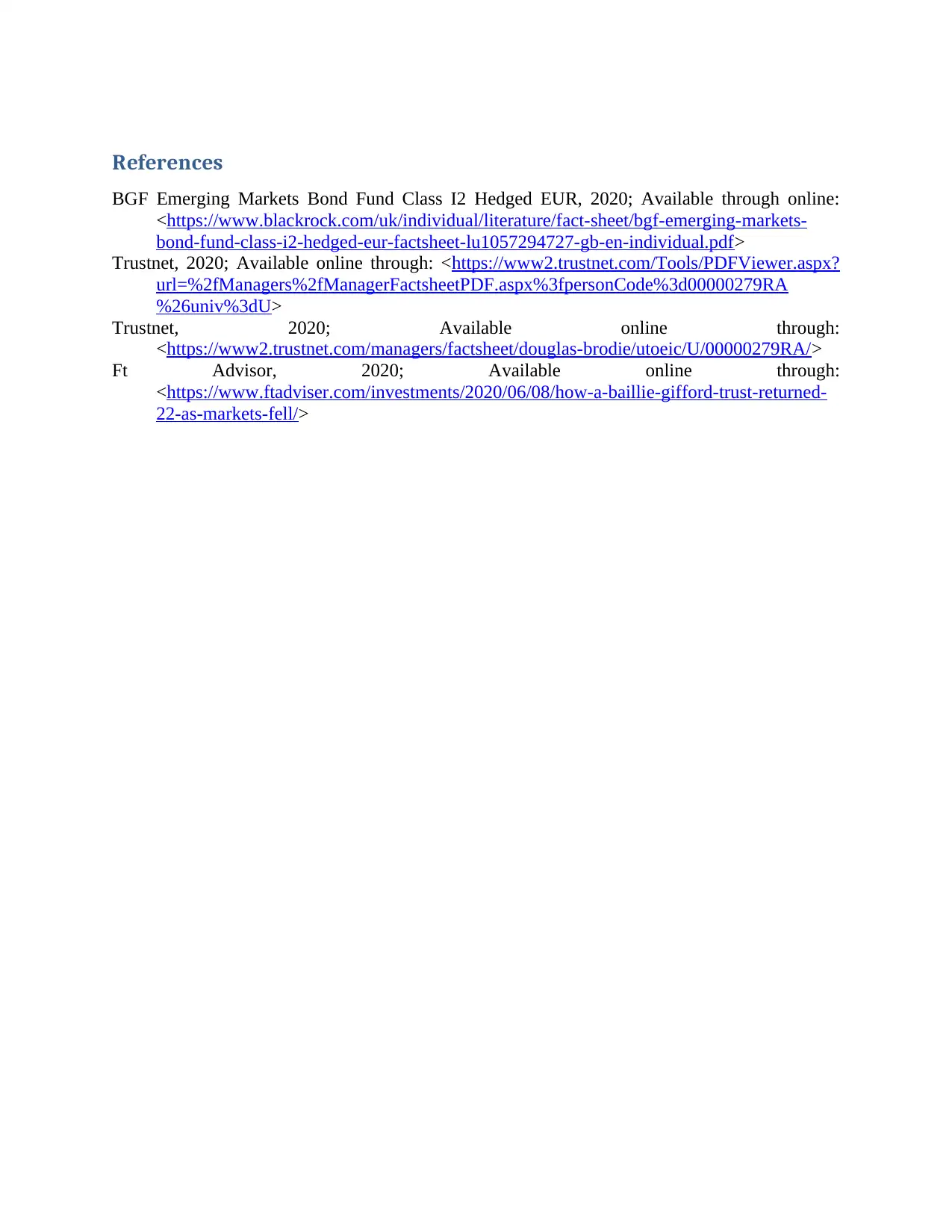
References
BGF Emerging Markets Bond Fund Class I2 Hedged EUR, 2020; Available through online:
<https://www.blackrock.com/uk/individual/literature/fact-sheet/bgf-emerging-markets-
bond-fund-class-i2-hedged-eur-factsheet-lu1057294727-gb-en-individual.pdf>
Trustnet, 2020; Available online through: <https://www2.trustnet.com/Tools/PDFViewer.aspx?
url=%2fManagers%2fManagerFactsheetPDF.aspx%3fpersonCode%3d00000279RA
%26univ%3dU>
Trustnet, 2020; Available online through:
<https://www2.trustnet.com/managers/factsheet/douglas-brodie/utoeic/U/00000279RA/>
Ft Advisor, 2020; Available online through:
<https://www.ftadviser.com/investments/2020/06/08/how-a-baillie-gifford-trust-returned-
22-as-markets-fell/>
BGF Emerging Markets Bond Fund Class I2 Hedged EUR, 2020; Available through online:
<https://www.blackrock.com/uk/individual/literature/fact-sheet/bgf-emerging-markets-
bond-fund-class-i2-hedged-eur-factsheet-lu1057294727-gb-en-individual.pdf>
Trustnet, 2020; Available online through: <https://www2.trustnet.com/Tools/PDFViewer.aspx?
url=%2fManagers%2fManagerFactsheetPDF.aspx%3fpersonCode%3d00000279RA
%26univ%3dU>
Trustnet, 2020; Available online through:
<https://www2.trustnet.com/managers/factsheet/douglas-brodie/utoeic/U/00000279RA/>
Ft Advisor, 2020; Available online through:
<https://www.ftadviser.com/investments/2020/06/08/how-a-baillie-gifford-trust-returned-
22-as-markets-fell/>
⊘ This is a preview!⊘
Do you want full access?
Subscribe today to unlock all pages.

Trusted by 1+ million students worldwide
1 out of 13
Related Documents
Your All-in-One AI-Powered Toolkit for Academic Success.
+13062052269
info@desklib.com
Available 24*7 on WhatsApp / Email
![[object Object]](/_next/static/media/star-bottom.7253800d.svg)
Unlock your academic potential
Copyright © 2020–2025 A2Z Services. All Rights Reserved. Developed and managed by ZUCOL.





